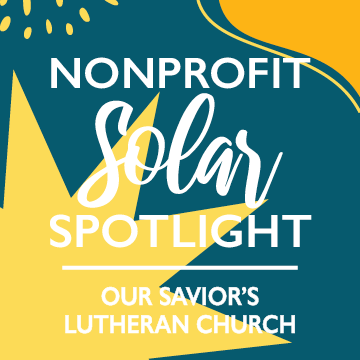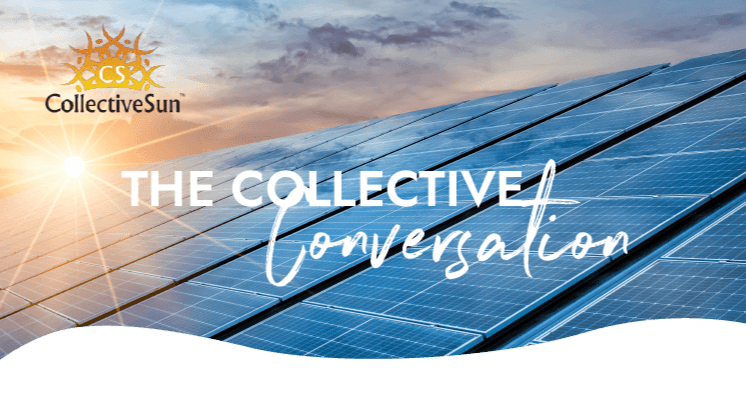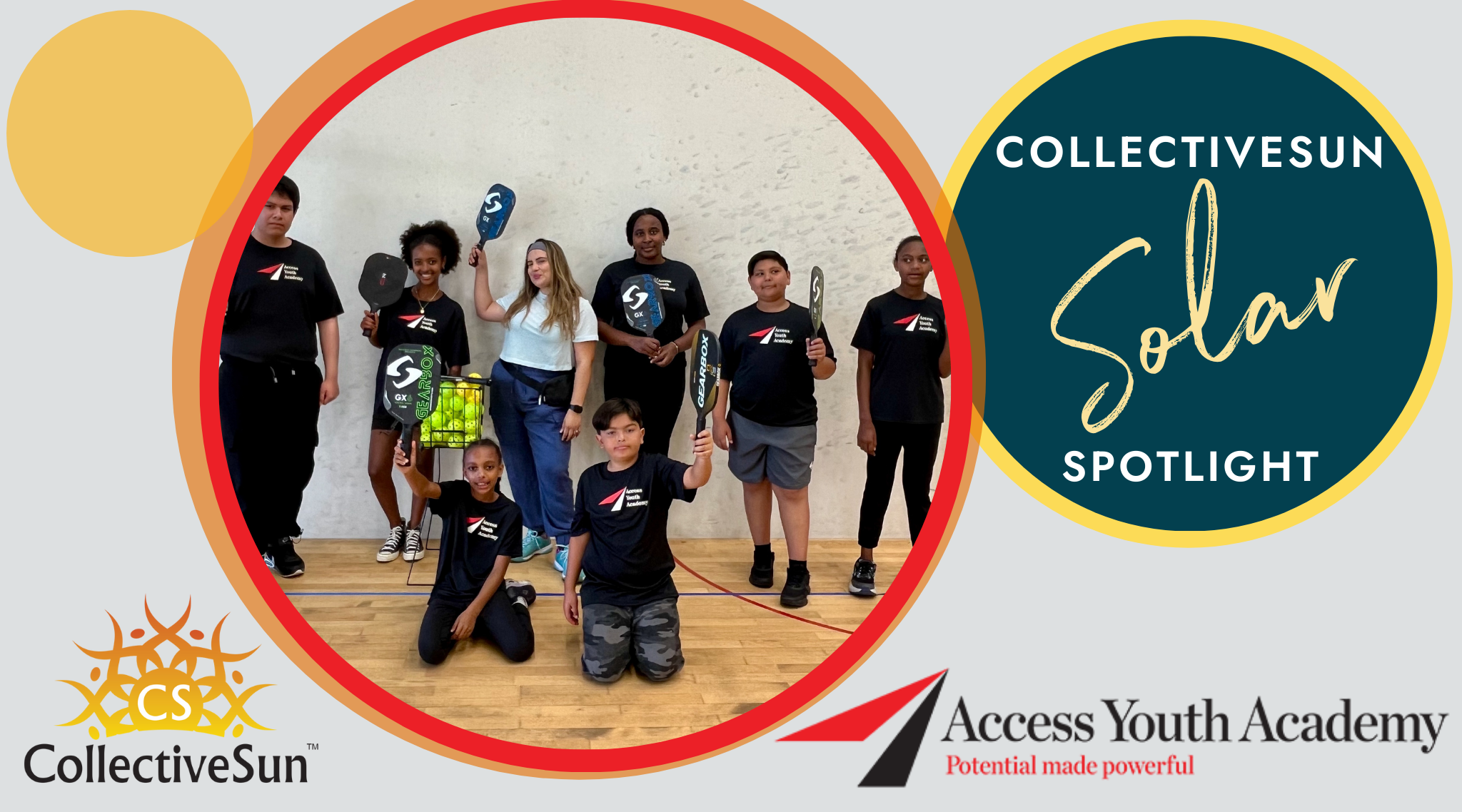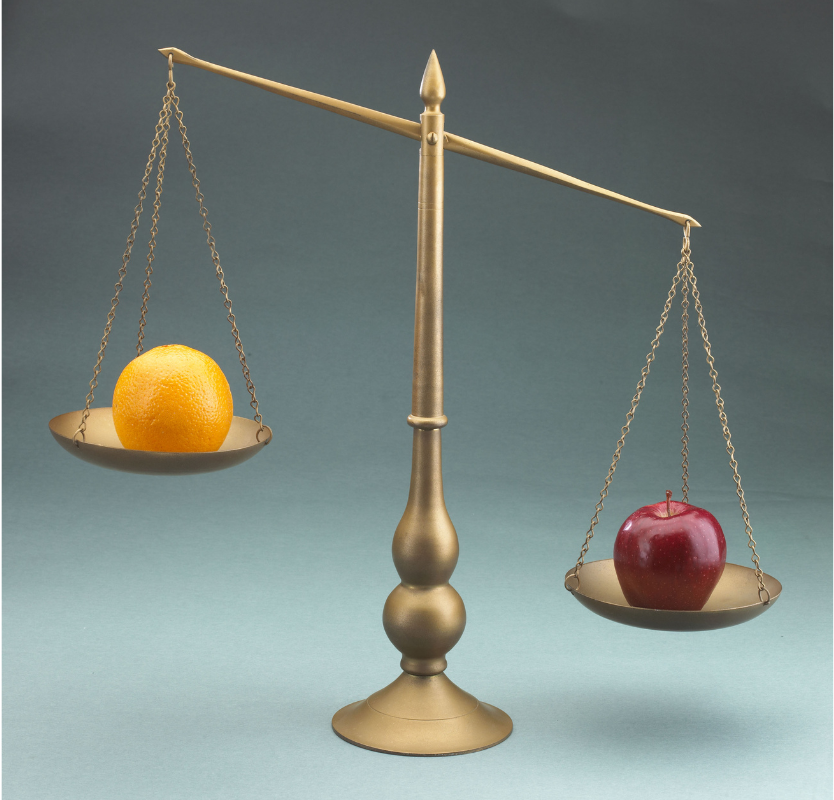
Nonprofit Solar Spotlight: Meet Our Savior’s Lutheran Church
Story by Sara Carbone, CollectiveSun Content Marketing Manager
Nonprofits are our passion at CollectiveSun! Particularly when it comes to helping them operate in the most financially sustainable way. Installing a solar system goes a long way towards making that a reality for these organizations, and it is often aligned with core values many of these organizations have about supporting the environment. Over the past four years CollectiveSun has partnered with over 140 nonprofits across 19 states to achieve their renewable energy goals.
The Nonprofit Solar Spotlight is a monthly series where we highlight nonprofits that are committed to clean energy and financial and environmental sustainability. These are the stories of organizations that have taken the leap into going solar and become leaders in their communities as examples of nonprofits lowering their operating expenses and helping to make a clean environment a reality.
Our first featured nonprofit was Massachusetts based Congregation Shaarei Tefillah. The second nonprofit of the series is Our Savior’s Lutheran Church in Lafayette, California. They partnered with CollectiveSun to go solar between in 2019 and installed a 56.25 kW system projected to save them over $680,000 over the system’s lifetime.
We spoke with Our Savior’s Senior Pastor Dan Senter and the church’s treasurer Chris House. Pastor Dan and Chris shared the story behind Our Savior’s mission and decision to go solar, as well as what it was like to work with CollectiveSun.
What is the story behind Our Savior’s Lutheran Church?
Dan: The congregation was built when Lafayette was relatively new back around 1948. This was a growing suburb that started off with just a few houses in the community which grew when the suburbs exploded, like so many churches. This church too exploded and as a result the actual site for Our Savior’s ended up being a huge eight acre plant that we now steward. We benefited from the vibrancy of the growth of the baby boomer generation that came out here to the suburbs and raised their kids and contributed to their local church. Now, most Protestant churches are in slow decline so our numbers have been in decline for the past 15-20 years.
So one of the challenges that we’ve faced as our congregation size has decreased is what to do with this huge site as a smaller congregation. We began to run a parallel effort onsite called Creekside Commons that is registered as a nonprofit. As a result the congregation established two entities: one that is a religious nonprofit and the other that is a community based nonprofit. Today we have 25 different nonprofits that call this place home, like a school for kids on the autism spectrum, that either have their office space here or hold their meetings here. We became part of the community by sharing our site with intentionality to support those causes in the community that we thought resonated with our values.
What are the main issues that Our Savior’s Lutheran Church focuses on?
Dan: One of the things that most congregations really have to figure out is the balancing act between trying to think of themselves as perpetuating denominational identity and honoring a certain spirit in the community that emerges over time. Probably the most significant thing that people value as they look at the legacy of community life in churches are the lay led initiatives that have been instigated over the years. Those are the things that people take the most pride in.
An example with Our Savior’s is that when the church first got started they did a big community outreach around a phone support system called Contact Care that would help people who are either suicidal or going through problems. It was so well accepted in the community that it became a kind of figurehead, that still exists today as Mobility Matters. Projects like this become part of our institutional memory and a clear indicator of our congregational identity and life.
That’s a beautiful thing about being in parish work; you’re always balancing perpetuating the denominational identity with continuing to elevate the passions of the people so that they are both embedded in the memory and legacy of the institution. When I think back on our trajectory, those have been the things that we’ve been vibrantly chipping away at to ensure that we’re establishing meaningful experience that becomes a history that people can look back on.
“The solar panel is the most visible indicator of the passion people have about combining a spiritual connection with the natural world. It’s the best kind of testimony when people walk onto the site.”
How is Our Savior’s Lutheran Church connected to Lafayette and the greater Bay Area community?
Dan: One example is our Community Supported Agriculture (CSA) program. The whole issue around sustainable agriculture became more and more important to folks in our church. So we began to partner with different farmers and created a pretty robust CSA program. Now we’re a hub for the community to come to every week and get vegetables that are grown locally and harvested sustainably. To date, we are a drop site for fruit, vegetables, eggs, meat, fish, and value add products that has turned our main hall into a grocery store. Every week it’s full of produce that people come by and pick up, with relationships to all these partner farms. We also helped launch what is called the Urban Farmers, a program that has volunteers harvesting backyard fruit that would normally fall to the ground to give to food shelters.
I would say that the congregation has these two different faces to the world. It still maintains a pretty strong spiritual center that is grounded in the denominational legacy but also has a wonderful and edgy collaborative enterprise where we work alongside the wider community.
A trend that started about 15 years ago was that people would identify as spiritual but not religious, no longer identifying with a particular denomination. So a congregation has to figure out how to pivot, to address the way in which the culture is manifesting or articulating their sense of spirituality. So we took that seriously and tried to move towards that while still supporting a congregation that identifies as Lutheran. It’s really worked beautifully.
What sparked Our Savior’s Lutheran Church’s interest in renewable energy and sustainability?
Dan: When people reflect on their most spiritual moments, most of them say that it’s in their relationship to nature. Because of that intimate spiritual bond with the natural world people want to behave in a way that supports the environment, to be in a relationship with the environment in a way that reflects their values. A number of years ago we began to look at the low hanging fruit regarding how to live out a just relationship with the planet because we knew it fostered a deeper sense of spirituality and connection. That began the journey that led us to the solar panels on our roof right now.
We started out with little things. We replaced all of our paper products with compostable products. Then we looked at our Sunday coffee hour and moved to a local source for our coffee beans – one that supports prisoners just out of prison and going through job retraining. Next we replaced lighting and put motion sensors in every room so the lights would not stay on. We tackled a couple of HVAC systems.
Every year solar was brought to the table. And every year our committee would feel that the price points were too difficult or that there was some other difficulty. So instead we switched our electrical source to a green one through MCE Community Choice Energy. It wasn’t until the roof started leaking so badly and we had to find the money to replace it that we decided it was the time to relook at solar. And that began that journey. Ultimately, in order to make the leap to solar, it had to be part of a longer narrative about the way in which the congregation self-identifies as passionate about doing things on behalf of the environment and then linking that journey to their spiritual lives.
Chris: I think what also really got our solar project over the line was people’s realization that being good stewards of our community’s financial resources is important and going solar is a very clear extension of that because of its dramatic impact on the church’s operating budget. We were fortunate to have the capital to be able to go with a project that now gives us free power to run the church on. The financial impact of investing that money with our foundation is nowhere near the estimated 15% internal rate of return we get from the solar system. And there’s no risk. The sun comes up every day, electrons get produced, and we turn the lights on and use those electrons. So the savings are almost automatic for our budget. When people saw it as a wonderful thing for our church’s financial situation, it was a lightbulb moment for folks who were on the fence.
How did you hear about CollectiveSun and what was it like to work with them?
Chris: As we started to research solar, we initially reached out to California Interfaith Power and Light because of our existing relationship with them. We looked through the vendors and suppliers that they recommended and found CollectiveSun. That’s when we learned how they could help us take advantage of the Solar Investment Tax Credit. This, plus other faith communities’ experiences with CollectiveSun, had us decide to call them.
Working with them brought cost savings, but we also really appreciated having another experienced partner involved with the project. They’ve done so many systems with so many installers and have seen it all. There were points in the project where we got the benefit of that level of experience, like getting a second set of eyes on our project proposal and adjusting details like making sure we had an extended warranty on our inverter. So there was a lot of value in engaging with CollectiveSun, even beyond the economic benefit.
Although in our situation we didn’t need to fundraise for the project, I was also impressed by CollectiveSun’s ability to walk us through that, should we have needed to run that kind of campaign. It would have been something very feasible to do because, given that the financial return on the project was so high, it would have been very easy to share some of our return with investors.
How was your experience working with your installer?
Chris: Our installer was Sun Light & Power in Berkley, CA. Not only did they provide us with an excellent proposal when we were taking bids, but they’ve also been in business since 1976 and are 100% employee owned. These things, along with the fact that they had done at least one project with CollectiveSun, resonated with us. In fact when we brought up the idea of involving CollectiveSun, Sun Light and Power remarked that they knew how the process of working with them went and that it was great to work with them. That really helped make our project go very smoothly.
The project coordination was seamless. Also, we had a roofing contractor and coordination around the roof tear off was probably the hardest part of the project. But the installer worked extremely well with the roofer. I was impressed by how everything went, all the way from getting the first proposal to getting permission to operate.
How do you see your decision to go solar and your commitment to sustainability impacting your organization and community?
Pastor Dan: The solar panel is the most visible indicator of the passion people have about combining a spiritual connection with the natural world. It’s the best kind of testimony when people walk onto the site. It says, “Wow this congregation must take that seriously.” Going solar is aligned with one of the core values that has emerged in this congregation, and I know people are deeply proud that they’ve been able to make that final step. The system is a dominant visual reminder of the passions that are percolating inside of this community, and it’s so visible that it literally tells the story over and over again when people drive by.
We ended up creating a walking labyrinth on our property that combines Earth and spirituality. People see this sort of place as a kind of a place where they can quietly center down and walk the labyrinth. And as they walk it, above their heads are all the solar panels and compostable plates and all the stuff we’ve done to be responsible around our relationship to the planet. This sustained effort has now become part of our institutional memory. We identify as passionate about these things that came in response to a sense of what faith and spirituality are about. It is how we are known within the wider community.
We have gotten some recognition in the wider community. We were granted The Green Award by Sustainable Lafayette for our work for the environment. We started creating events for the community that were based on Earth based celebrations like Earth Day, winter and summer solstice and equinox. We folded spiritual and secular elements all together in one, with opportunities for people to take action. That got us invited to the annual event downtown that celebrates Earth Day, so we were able to set up a booth and tell our story there.
Any particular advice to other communities of faith looking at solar?
Chris: For me it would be just do it now. The tax credit has been extended, which is a great thing, but it may not be here forever. I think they’ll be surprised when they look at the economic benefits of solar to their budget.
Pastor Dan: One of the reasons why we got solar was that we slowly developed an environment in which the project could land that was based on a long term trajectory of doing small things, then slightly bigger things, until we built the momentum that allowed us to arrive at solar. So I would tell congregations that while you might not be ready to bite off solar right away, your community can take small steps that might lead you there.
Our Savior’s Lutheran Church’s solar project was installed by Sun Light & Power in Berkley, CA
About Our Savior’s Lutheran Church
Our Savior’s Lutheran Church is a congregation of the Evangelical Lutheran Church in America. They are a community embraced by the mystery of God’s love for all creation. OSLC strives to live with loving hearts, open minds, and hands extended to all.
Our Savior’s Lutheran Church’s Mission Statement:
We are a community attentive to the life and teachings of Jesus.
- We embrace an open approach to every spiritual journey.
- We ask questions together and value every voice.
- We strive for justice through service to the world.
We seek to be transformed by the path we walk together.
About Pastor Dan Senter
Pastor Dan works with all of our great volunteers, staff, community partners, Fellowship recipients, and Ministry in Context Students, to connect our community to all that is sacred within the experience of life. His work is intellectually stimulating, thoughtful, creative, and connected to the best of modern scholarship. Pastor Dan’s work to design OSLC’s Festival Sundays and public events provides a chance for him to work with outside artists, poets, musicians, and attendees to create events that connect us to the sacred in wonderful ways.
He is a strong advocate for environmental justice and works closely with the Interfaith Sustainable Food Collaborative to develop CSA programs that link farmers and communities together.
As Senior Pastor he also spends much of his time managing the nuts and bolts that help hold a faith community together and keep it on track. Dan and his wife, Laurie, have two adult children and three grandchildren. They are committed to great food, edgy theater, long bike rides, old cars, and one another.




 Spotlight on Access Youth Academy, IRS resources, comparing solar quotes, and more!...
Spotlight on Access Youth Academy, IRS resources, comparing solar quotes, and more!...

